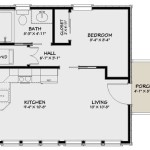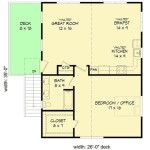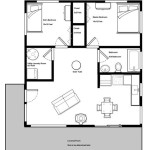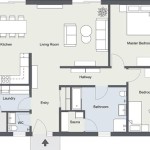Ranch Style Home Plans: A Comprehensive Overview
Ranch style homes, also known as ramblers, emerged as a significant architectural trend in the United States during the mid-20th century. Their popularity stems from their simplicity, functionality, and adaptability to various lifestyles. Characterized by their single-story design and emphasis on horizontal lines, ranch homes offer a comfortable and accessible living experience. Understanding the nuances of ranch style home plans is crucial for those considering building or renovating such a dwelling.
The enduring appeal of ranch homes lies in their inherent practicality. The single-story layout eliminates the need for stairs, making them ideal for families with young children, individuals with mobility issues, and those seeking ease of maintenance. Furthermore, ranch homes often feature open floor plans that promote social interaction and create a sense of spaciousness. These characteristics contribute to the lasting desirability of ranch-style architecture.
This article provides a comprehensive overview of ranch style home plans, examining their key features, variations, considerations for design, and relevant architectural elements. The information presented aims to equip potential homeowners with a foundational understanding of this architectural style, enabling them to make informed decisions regarding their housing needs and preferences.
Key Features of Ranch Style Homes
Several defining characteristics distinguish ranch homes from other architectural styles. Recognizing these features is essential for identifying and appreciating the unique qualities of this type of dwelling. These features include the single-story layout, low-pitched roof, open floor plan, and attached garage.
The single-story design, perhaps the most prominent feature, contributes significantly to the accessibility and convenience of ranch homes. This eliminates the challenges posed by stairs, making the homes suitable for individuals of all ages and physical abilities. It also simplifies tasks such as laundry and cleaning, streamlining household management.
Low-pitched roofs, often with wide eaves, are another hallmark of ranch style architecture. These roofs contribute to the horizontal emphasis of the design and offer protection from the elements. The overhanging eaves provide shade and prevent rainwater from directly contacting the exterior walls, thereby reducing the risk of water damage.
Open floor plans, which integrate living, dining, and kitchen areas, are common in ranch homes. This design promotes a sense of spaciousness and encourages social interaction. The seamless flow between these areas facilitates communication and creates a more connected living environment. The open layout also allows for greater flexibility in furniture arrangement and interior design.
An attached garage is typically incorporated into ranch style homes, providing convenient and secure parking. This feature adds to the practicality of the design, offering direct access to the home from the garage, which is particularly beneficial during inclement weather. The garage can also serve as additional storage space or a workshop area.
Variations in Ranch Style Home Plans
While the core features of ranch homes remain consistent, various subtypes have emerged over time, reflecting evolving architectural trends and regional preferences. Understanding these variations allows for a more nuanced appreciation of the diversity within the ranch style. Some common variations include the California ranch, the suburban ranch, and the split-level ranch.
The California ranch, often considered the quintessential ranch style, is characterized by its expansive layout and integration with outdoor living spaces. These homes typically feature large windows, sliding glass doors, and patios or courtyards that seamlessly connect the interior and exterior environments. Emphasis is placed on natural light and ventilation, creating a bright and airy living space.
The suburban ranch, a more compact version of the California ranch, is commonly found in suburban neighborhoods. These homes often feature a rectangular or L-shaped layout and are designed to maximize space efficiency. While maintaining the key features of ranch style architecture, the suburban ranch is adapted to smaller lot sizes and more densely populated areas.
The split-level ranch, a variation that gained popularity in the mid-20th century, incorporates multiple levels connected by short flights of stairs. This design allows for a greater separation of living spaces, with different levels dedicated to different functions, such as sleeping, living, and recreation. While not strictly a single-story design, the split-level ranch retains the horizontal emphasis and attached garage characteristic of the ranch style.
A further variation is the raised ranch. Raised ranch homes offer an interesting floor plan with the main living area elevated above the foundation level. This can offer better views and improved natural light for the living spaces. The lower level often contains a garage and can be finished for additional living space, making raised ranch homes a versatile option.
Considerations for Designing a Ranch Style Home
Designing a ranch style home requires careful consideration of various factors, including site orientation, spatial planning, and material selection. Attention to these aspects ensures a functional, aesthetically pleasing, and energy-efficient dwelling. Proper planning is essential for maximizing the benefits of ranch style architecture.
Site orientation is a crucial consideration, as it affects the home's exposure to sunlight and wind. Orienting the home to maximize southern exposure can enhance natural lighting and passive solar heating, reducing energy consumption. Strategic placement of windows and overhangs can also help control solar gain and prevent overheating during the summer months.
Spatial planning involves arranging the interior spaces to optimize functionality and flow. An open floor plan should be carefully designed to ensure adequate separation between living areas while maintaining a sense of connectedness. Consideration should be given to traffic patterns and the placement of furniture to create a comfortable and efficient living environment.
Material selection plays a significant role in the aesthetic appeal and durability of the home. Ranch homes are often constructed with natural materials such as wood, brick, and stone, which contribute to their rustic and timeless character. Selecting durable and low-maintenance materials can reduce long-term maintenance costs and ensure the longevity of the home.
Accessibility is another critical aspect to consider, given the single-story nature of ranch homes. Designing doorways and hallways to accommodate wheelchairs or walkers can enhance the home's accessibility for individuals with mobility challenges. Incorporating features such as grab bars in bathrooms and ramps at entrances can further improve accessibility and promote independent living.
Energy efficiency should be a priority in the design process. Incorporating features such as energy-efficient windows, insulation, and HVAC systems can significantly reduce energy consumption and lower utility bills. Utilizing sustainable building practices and materials can further enhance the environmental friendliness of the home.
Moreover, consider the landscape design around the ranch home. The landscaping should complement the architectural style of the house. Consider planting drought-resistant native species to reduce water consumption and create a low-maintenance yard. Patios and decks should be positioned to maximize outdoor living space and provide opportunities for relaxation and entertainment.
Interior design is also key to truly embracing the ranch style. Think about using mid-century modern furniture, natural colors, and textures. Large windows and sliding glass doors allow plenty of natural light, so avoid heavy window treatments. Consider adding a fireplace as a focal point in the living area. Using open shelving can enhance the feeling of space and display personal items.
Finally, think about adding a home office or flex space within the ranch home plan. With more people working from home, a dedicated workspace is essential. This space can also be used as a library, craft room, or play area, depending on the homeowner's needs. Proper lighting and soundproofing are crucial for creating a productive and comfortable workspace.
By considering these factors, potential homeowners can create a ranch style home that meets their specific needs and preferences, while embracing the timeless appeal and practicality of this architectural style. Ranch homes offer a unique opportunity to blend indoor and outdoor living, create a comfortable and accessible environment, and express personal style through design choices.

Ranch House Plans Style Home Designs The Designers

Ranch House Plans Style Home Designs The Designers

4 Bedroom Classic Ranch House Plan With Covered Porch

Tierney Ranch House Plans Luxury Floor

Beautifully Simple Ranch House Plans Dfd Blog

Ranch Style House Plan 3 Beds 5 Baths 2974 Sq Ft 430 242 Houseplans Com

Ranch House Plans With Open Floor Blog Homeplans Com

Ranch Style House Plans Modern Homes Floor Plan Buildmax

Ranch House Plans Traditional Floor

Cameron Walk House Floor Plan Frank Betz Associates








